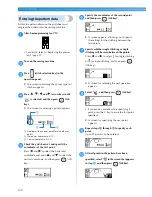
APPENDIX
—————————————————————————————————————————————————————
138
▲
There are knots or tangles in the
thread.
Remove any knots or tangles.
–
The upper
thread breaks.
The selected needle is not
appropriate for the thread being
used.
Select a needle that is appropriate
for the type of stitch being used.
page 33
The upper thread tension is too tight. Loosen the upper thread tension.
page 54
The thread is tangled, for example,
in the shuttle.
Remove the tangle thread. If the
thread is tangled in the shuttle, clean
the shuttle.
page 135
The needle is bent or blunt.
Replace the needle.
page 34
The needle is incorrectly installed.
Correctly install the needle.
The area around the hole in the
needle plate is scratched, or has a
burr on it.
Replace the needle plate.
Contact your retailer or the nearest
authorized service center.
–
The area around the hole in the
presser foot is scratched, or has a
burr on it.
Replace the presser foot.
Contact your retailer or the nearest
authorized service center.
–
The shuttle is scratched, or has a
burr on it.
Replace the shuttle.
Contact your retailer or the nearest
authorized service center.
–
A bobbin designed specifically for
this machine is not used.
Incorrect bobbins will not work
properly. Only use a bobbin designed
specifically for this machine.
page 18
The lower
thread is tangled
or breaks.
The bobbin thread is incorrectly
installed.
Correctly install the bobbin thread.
page 22
The bobbin is scratched or does not
rotate smoothly, or has a burr on it.
Replace the bobbin.
–
The thread is tangled.
Remove the tangled thread and
clean the shuttle.
page 135
A bobbin designed specifically for
this machine is not used.
Incorrect bobbins will not work
properly. Only use a bobbin designed
specifically for this machine.
page 18
The thread
tension is
incorrect.
The upper thread was not threaded
correctly.
Correct the upper threading.
page 24
The bobbin thread is incorrectly
installed.
Correctly install the bobbin thread.
page 22
The combination of fabric, thread
and needle is not correct.
Select a thread and needle that are
appropriate for the type of fabric
being sewn.
page 33
The presser foot holder is incorrectly
installed.
Correctly install the presser foot
holder.
page 39
The thread tension is incorrect.
Adjust the tension of the upper
thread.
page 54
A bobbin designed specifically for
this machine is not used.
Incorrect bobbins will not work
properly. Only use a bobbin
designed specifically for this
machine.
page 18
Symptom
Probable Cause
Remedy
Reference
Summary of Contents for 885-S61
Page 50: ...GETTING READY 44 ...
Page 72: ...SEWING BASICS 66 ...
Page 152: ...APPENDIX 146 Z zipper stitching 85 89 ...
Page 153: ......
Page 154: ......
Page 155: ......













































